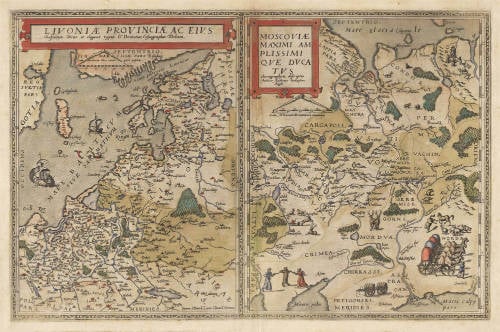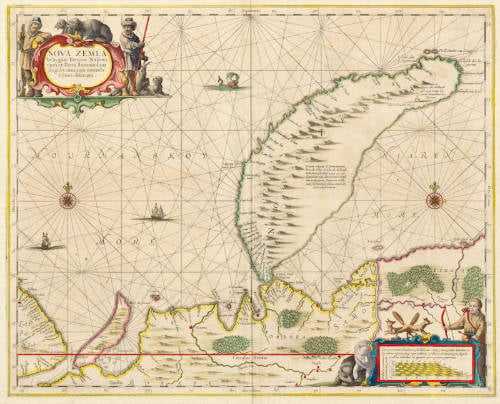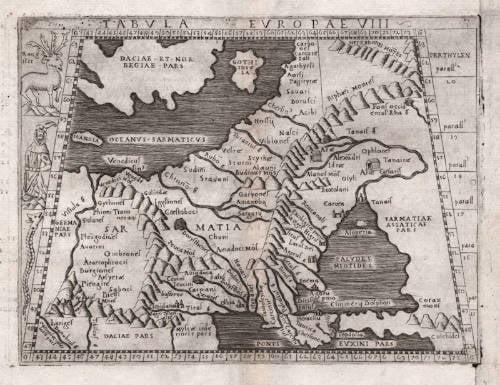Leen Helmink Antique Maps
Antique map of Russia, Eastern Europe and Scandinavia by Berlinghieri / Ptolemy
Stock number: 18827
Zoom ImageTitle
Tabula Octava de Europa
First Published
Florence, 1482
This Edition
1482
Size
39.5 x 47 cms
Technique
Condition
excellent
Price
$ 10,000.00
(Convert price to other currencies)
Description
Very early and extremely rare Ptolemaic incunabula map centered on Russia, Poland, Belarus, Ukraine, the Baltic States, much of central and eastern Europe, and Northern Europe. The map stretches from the Vistula River in the west to the Tanais (Don) river in the east, and from the Baltic at the top to the Black Sea at the bottom.
Much of the lettering is not engraved, but carried out with letter punches.
It is only the third printed edition of Ptolemy's Geographica with maps, preceded only by the 1477 Bologna and the 1478 Rome editions. The first atlas to be printed in the vernacular, and the first atlas expanded with modern maps. They are also the first maps to use the projection of Marinus of Tyre, instead of Ptolemy's projection.
The map is of exceptional rarity. The last example was offered by Dick Arkway in 2008, and is in fact this very same copy.
Condition
First and only edition of this highly significant map. A good imprint of the copperplate. Two sheets joined, with some minor centerfold restorations as always (because the map was stitched it the atlas, instead of glued to a paper stub). Ample margins all around. Excellent collector's condition.
Francesco Berlinghieri (1440-1501)
Francesco di Nicoli Berlinghieri (1440-1501) was a member of an old Florentine family and he held a number of official posts in that city. He was hardly a geographer and certainly in no sense a cartographer.
The identity of the engraver of the maps remains in dispute but it is believed by some to be Francesco Roselli who was one of the earliest known map sellers and active in Florence up to his death in 1513.
The maps in Berlinghieri's atlas are the only ones in any edition of Ptolemy printed on the original Ptolemaic projection with equidistant meridians and parallels. Unlike other early Ptolemaic atlases, sets of Berlinghieri's maps were sold separately without text. The maps were not reprinted.
Claudius Ptolemy (c.100 - c.170)
Ptolemy, Latin in full Claudius Ptolemaeus was an Egyptian astronomer, mathematician, and geographer of Greek descent who flourished in Alexandria during the 2nd century AD. In several fields his writings represent the culminating achievement of Greco-Roman science, particularly his geocentric (Earth-centred) model of the universe now known as the Ptolemaic system.
Virtually nothing is known about Ptolemy’s life except what can be inferred from his writings. His first major astronomical work, the Almagest, was completed about 150 ce and contains reports of astronomical observations that Ptolemy had made over the preceding quarter of a century. The size and content of his subsequent literary production suggests that he lived until about 170 AD.
Astronomer
The book that is now generally known as the Almagest (from a hybrid of Arabic and Greek, “the greatest”) was called by Ptolemy Hē mathēmatikē syntaxis (“The Mathematical Collection”) because he believed that its subject, the motions of the heavenly bodies, could be explained in mathematical terms.
Mathematician
Ptolemy has a prominent place in the history of mathematics primarily because of the mathematical methods he applied to astronomical problems. His contributions to trigonometry are especially important. For instance, Ptolemy’s table of the lengths of chords in a circle is the earliest surviving table of a trigonometric function. He also applied fundamental theorems in spherical trigonometry (apparently discovered half a century earlier by Menelaus of Alexandria) to the solution of many basic astronomical problems.
Among Ptolemy’s earliest treatises, the Harmonics investigated musical theory while steering a middle course between an extreme empiricism and the mystical arithmetical speculations associated with Pythagoreanism. Ptolemy’s discussion of the roles of reason and the senses in acquiring scientific knowledge have bearing beyond music theory.
Geographer
Ptolemy’s fame as a geographer is hardly less than his fame as an astronomer. Geōgraphikē hyphēgēsis (Guide to Geography) provided all the information and techniques required to draw maps of the portion of the world known by Ptolemy’s contemporaries. By his own admission, Ptolemy did not attempt to collect and sift all the geographical data on which his maps were based. Instead, he based them on the maps and writings of Marinus of Tyre (c. 100 ce), only selectively introducing more current information, chiefly concerning the Asian and African coasts of the Indian Ocean. Nothing would be known about Marinus if Ptolemy had not preserved the substance of his cartographical work.
Ptolemy’s most important geographical innovation was to record longitudes and latitudes in degrees for roughly 8,000 locations on his world map, making it possible to make an exact duplicate of his map. Hence, we possess a clear and detailed image of the inhabited world as it was known to a resident of the Roman Empire at its height—a world that extended from the Shetland Islands in the north to the sources of the Nile in the south, from the Canary Islands in the west to China and Southeast Asia in the east. Ptolemy’s map is seriously distorted in size and orientation compared with modern maps, a reflection of the incomplete and inaccurate descriptions of road systems and trade routes at his disposal.
Ptolemy also devised two ways of drawing a grid of lines on a flat map to represent the circles of latitude and longitude on the globe. His grid gives a visual impression of Earth’s spherical surface and also, to a limited extent, preserves the proportionality of distances. The more sophisticated of these map projections, using circular arcs to represent both parallels and meridians, anticipated later area-preserving projections. Ptolemy’s geographical work was almost unknown in Europe until about 1300, when Byzantine scholars began producing many manuscript copies, several of them illustrated with expert reconstructions of Ptolemy’s maps. The Italian Jacopo d’Angelo translated the work into Latin in 1406. The numerous Latin manuscripts and early print editions of Ptolemy’s Guide to Geography, most of them accompanied by maps, attest to the profound impression this work made upon its rediscovery by Renaissance humanists.
(Britannica)
Related Categories
Related Items






